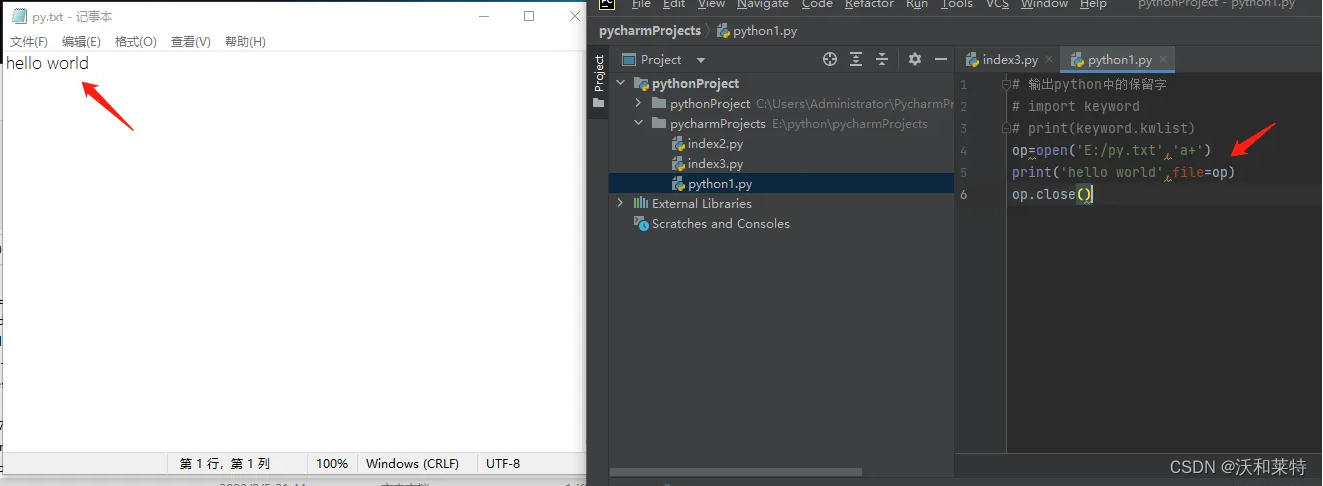前言
Python是一种跨平台的计算机程序设计语言,是ABC语言的替代品,
属于面向对象的动态类型语言
,最初被设计用于编写自动化脚本,随着版本的不断更新和语言新功能的添加,越来越多被用于独立的、大型项目的开发。
从这篇文章开始,我们就步入python的学习。从入门到实战,不断超越昨天的自己!
输出函数print()
1:python中的输出函数是
print()函数
,利用print()函数输出 ‘hello world’
2:利用print()函数直接可以输出数字,print(3.14) ;当需要输出字符串时,我们需要用
单引号或者是双引号
括起来才能正常输出:
print("helloworld")print('helloworld')
3:可以直接输出含有运算符的表达式的结果:
print(1+2)#输出3
4:将内容输出到一行中,需要输出的数据需要用逗号隔开:
print('hello','world','你好世界')#hello world 你好世界
5:将数据输出到指定文件中:
op=open('E:/py.txt','a+')#a+表示如果文件不存在就另创建,如果存在就在改文件中持续追加指定内容print('hello world',file=op)
op.close()#需要注意:所指定的磁盘符要存在;利用file=某一变量 的方式输出

转义字符
转义字符的使用
\
加上
所需功能的首字母
:比如,newline 表示换行,那么
\n
就表示 换行功能,并且光标自动移动到下一行的开头:
print('你好\n世界')'''
你好
世界
'''
以下是几个常用的转义字符:
标识符和保留字
python中的标识符(变量,函数,类,模块和其他对象起的名字)的命名规则:
1:以字母、数字、下划线组成;
2:不能以数字开头;
3:不能是保留字;严格区分大小写。
python中的保留字:
在pycharm中我们可以输入这两行代码查询出python中的保留字:
import keyword
print(keyword.kwlist)

[‘False’, ‘None’, ‘True’, ‘and’, ‘as’, ‘assert’, ‘async’, ‘await’, ‘break’, ‘class’, ‘continue’, ‘def’, ‘del’,
‘elif’, ‘else’, ‘except’, ‘finally’, ‘for’, ‘from’, ‘global’, ‘if’, ‘import’, ‘in’, ‘is’, ‘lambda’, ‘nonlocal’,
‘not’, ‘or’, ‘pass’, ‘raise’, ‘return’, ‘try’, ‘while’, ‘with’, ‘yield’]
变量和内存
python中的变量是由三部分组成:标识(id 内存地址),类型,值
name='李华'print('标识:',id(name))print('类型:',type(name))print('值:',name)

数据类型
常用的数据类型有
整数类型:int
浮点类型:float
布尔类型:bool 返回True或False
字符串类型:str
1:整数类型
print('二进制',0b10101111)#二进制以0b开头print('八进制',0o176)#八进制以0o开头print('十进制',118)print('十六进制',0x1EAF)#十六进制以0x开头

2:浮点类型
浮点数数据类型是由
整数部分和小数部分
组成的;浮点数存储不精确,使用浮点数进行计算时,可能会出现小数位不确定的情况;
解决方案:导入模块decimal
from decimal import Decimal
print('直接计算:',1.2+2.2)print('导入模块后计算:',Decimal('1.2')+Decimal('2.2'))'''
直接计算: 3.4000000000000004
导入模块后计算: 3.4
'''
3:布尔类型
python一切皆对象,所有的对象都有一个布尔值 , 获取对象的布尔值使用内置函数
bool()
以下对象的布尔值是False : False() ,整数值0、浮点数值0.0等, None 空字符串, 空列表, 空元组, 空字典, 空集合
用来表示真和假的值 :
True和False(注意首字母大写)
;
布尔值可以转化为整数类型:true转换成 1,false转换成 0
print(True+1)#2print(False+1)#1
4:字符串类型
a1 ='人生苦短,我用python'
a2 ="人生苦短,我用python"
a3 ="""人生苦短,
我用python"""# 三引号:在引号中的内容都是可以换行写的
a4 ='''人生苦短,
我用python'''print(a1,type(a1),)print(a2,type(a2))print(a3,type(a3))print(a4,type(a4))# 都是字符串类型

我们可以使用
format
来格式化字符串 :
格式:string{}.format(x1, x2)
price =15
obj ='shirt'print("The {}'s price is {}".format(obj, price))#The shirt's price is 15
还可以指定位置:
string{0}.format(x1, x2)
price =15
obj ='shirt'print("The {0}'s price is {1}".format(obj, price))#The shirt's price is 15
数据类型转换
1:转换成字符串str()
a=10
b=True
c=23.32print(a,type(a),b,type(b),c,type(c))print('-----------str()将其他类型转换成str类型----------')print(str(a),type(str(a)),str(b),type(str(b)),str(c),type(str(c)))

2:转换成整数型int()
print('-------int()将其他类型转换为int类型转换之前--------')
b1='123'
b2=98.7
b3=True
b4='hello'
b5="12.32"print(type(b1),type(b2),type(b3),type(b4))print('-------int()将其他类型转换为int类型转换之后--------')print(int(b1),type(int(b1)))#字符串类型转换为int类型,前提是字符串是整数数字串print(int(b2),type(int(b2)))#浮点类型转换为int类型,取整数部分print(int(b3),type(int(b3)))#布尔类型转化为int类型,True-->1;False-->0print(int(b4),type(int(b4)))#非整数数字串的字符串无法转换成int类型print(int(b5),type(int(b5)))#小数字符串无法转换成整数类型

3:转换成浮点型 float()
print('-------float()函数将数据转换成浮点类型之前--------')
c1='123.321'
c2='12'
c3=True
c4=90
c5="hello"print(c1,type(c1),c2,type(c2),c3,type(c3),c4,type(c4),c4,type(c5))print('--------float()函数将数据转换成浮点类型之后------')print(float(c1),type(float(c1)))#小数字符串直接转出来print(float(c2),type(float(c2)))#整数字符串在整数后面加上.0print(float(c3),type(float(c3)))#布尔类型转换成数字后加小数点和0print(float(c4),type(float(c4)))#int类型在数字后加.和0print(float(c5),type(float(c5)))#非数字型的字符串不允许转换

输入函数input()
python中的输入函数是
input()函数
,使用input()函数可以用键盘录入信息,注意,使用input()函数返回的数据类型都是
字符串类型
,可以根据需求进行类型转换。
present=input('请输入:')print(present,type(present))# input()函数的练习----要求键盘录入两个整数,并计算出两个整数的和,将其打印在控制台#将返回的数据转换成int型
num1=int(input('请输入第一个数:'))
num2=int(input('请输入第二个数:'))
num3=num1+num2
print(num3,type(num3))

每篇一语
及时当勉励,岁月不待人。
如有不足,感谢指正!
版权归原作者 沃和莱特 所有, 如有侵权,请联系我们删除。